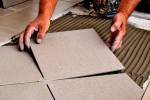Installing pedestal sink usually requires changing flooring
Q: I am starting a bathroom remodel and would like to install a pedestal sink. It looks pretty easy to do, but I would like some guidance.
A: A pedestal sink can make a lot of sense. If you are removing a boxy vanity and installing a pedestal sink, you can make the bathroom appear larger. In a small bathroom, this is a big plus.
On the downside, you will lose storage space, as the pedestal does not have drawers. It’s the age-old fight: pitting space against storage.
Realize that when you get rid of a vanity, the flooring will need to be changed because the vanity was placed before the flooring went in. All this means is that you will have a footprint of the vanity surrounded by your old flooring. So, if you are going to install a pedestal sink, you may want to install the new flooring first (especially if you are installing ceramic tile).
You may have to alter the drainpipe going into the wall by shortening it. Also, the water supply valves may stick out too far, so you may want to trim them closer to the wall. With the pedestal base as narrow as it is, it may not hide these valves.
The alternative is to repipe these valves so that they are more hidden, but this is a more challenging job which will require cutting open the wall, changing the direction of the pipes and patching the drywall. Most people choose to let the valves be seen.
The first thing to do is to dry fit the sink to the wall. Place the pedestal and sink in position, level it and, using a pencil, draw a light line around the sink where it meets the wall. The manufacturer will recommend where to mark on the wall for the location of the bracket.
Do the same where the base of the pedestal meets the floor. There will be two holes in the base of the pedestal and two holes under the sink where it meets the wall. These are for securing the fixture to the surfaces.
The typical installation is to mount a bracket to the wall and the pedestal to the floor. The sink hangs from the bracket and rests on the pedestal, and then the pieces are secured to the surfaces.
When you install the bracket, you must secure it into lumber or you risk pulling down parts of the wallboard. If you don’t have any blocking in the area where you are mounting the sink, you should add a 2-by-4 block between the wall studs for support. This is the correct way to do it.
However, I have seen many cases where installers won’t use blocking but instead just use an adhesive caulk to secure the sink against the wall. The adhesive caulking does a pretty nice job, but you run the risk of damage and/or injury if, for example, a child hangs on the front of the sink.
To do it the right way will require you to open the wall inside your pencil outline and install a 2-by-4 block. Cut gently and shallow so you don’t hit any pipes. Cut a 2-by-4 to fit between the wall studs and turn it so that the tall side is facing out. Angle some screws through the 2-by-4 and into the studs.
Cover the hole with greenboard (water-resistant wallboard). Stick some fiberglass tape over the edges of the patch and then apply drywall compound over the tape. Let it dry, sand it and then install the bracket over the greenboard and into the 2-by-4 block with lag bolts.
Set the pedestal into position and secure it to the floor. You can use lag bolts if the floor is wood or concrete anchors if the floor is concrete or tile (adhesive is often used here, too).
Install the faucet and drain assembly on the sink and set the sink on top of the pedestal. The bracket supports the back of the sink, and the pedestal supports the bottom of the sink. Insert lag bolts into the holes at the bottom of the sink and tighten them firmly, but do not overtighten.
The last step is to attach the plumbing. Reinstall the trap and drain line, and connect the water supply lines to the faucet. Turn on the valves and check for leaks. Leaks can usually be stopped with an extra quarter turn of the nut.
Mike Klimek is a licensed contractor and owner of Las Vegas Handyman. Questions may be sent by email to: handymanoflasvegas@msn.com. Or, mail to: 4710 W. Dewey Drive, No. 100, Las Vegas, NV 89118. His Web address is www.handymanoflasvegas.com.




























